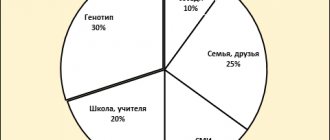Moral
They demonstrate a person’s attitude towards people, towards the Fatherland, towards his family, towards himself. These feelings include love, humanism, respect for the Motherland, responsiveness, loyalty, and dignity. The diversity of moral feelings reflects the brightness of human relationships. These feelings control human behavior.
Finished works on a similar topic
- Coursework Types of feelings 440 rub.
- Abstract Types of feelings 240 rub.
- Test work Types of feelings 250 rub.
Receive completed work or specialist advice on your educational project Find out the cost
Classification of feelings
The versatility of feelings, their manifestation at various levels of reflection and activity, the ability to merge and combine, and their adaptive nature exclude the possibility of a simple linear classification.
Feelings differ in modality, intensity, duration, depth, awareness, genetic origin, complexity, conditions of occurrence, functions performed, impact on the body, forms and levels of their development, mental processes with which they are associated, needs, subject content.
Existing classifications differ in their theoretical and empirical validity. A special group consists of higher feelings, which, depending on their orientation, are divided into the following groups .
Ethical - depend on knowledge of the norms of behavior, the requirements of morality accepted in a given society, express a person’s attitude towards other people; these are feelings of camaraderie, duty, repentance, etc.
The measure of the development of ethical feelings is the ability to self-control in actions - conscience. Ethical feelings include the so-called “parental feelings” - love, tenderness, responsibility.
Intellectual - associated with cognitive activity, acquiring knowledge, solving problems, tasks - curiosity, surprise, doubt, confidence.
Practical - associated with human activity, arising as a response to it - interest, passion, excitement, tension, feeling of something new, pleasure from completing a task, from receiving the result of work.
Aesthetic - their source is works of art, natural phenomena, human relationships. A wide range of these feelings is possible - from pleasure, enjoyment to aesthetic delight.
All feelings are subjective, but are determined by a positive or negative attitude towards life, people, and activities. They can be vague and ambiguous.
Intellectual, practical, aesthetic feelings arise in unity with moral feelings and are enriched in connection with them.
According to the degree of generalization of the subject content, feelings are divided into:
- specific ( for example, a feeling for a child, a work of art);
- generalized (feelings for children in general, for music);
- abstract (sense of justice, tragic).
In the mental makeup of a person, emotions and feelings are distinguished, which have become a stable emotional characteristic of the individual. According to the degree of brightness and depth of experience, people are characterized as emotional, sentimental, passionate and cold.
Emotions in psychology
When talking about such a phenomenon as emotions, many people, due to lack of knowledge, compare them with feelings. But this is not entirely fair. Emotions in psychology are a reaction (namely, an external manifestation) to certain phenomena, events or the action of stimuli. This is kind of one of the components of such a concept as feelings. Emotions express externally what a person experiences deep within himself.
The emotional process is accompanied by such manifestations as:
- Interest in any phenomena or facts.
- Joy from positive events.
- Surprise, which cannot be classified as either positive or negative emotions, since it does not clearly define the attitude towards certain facts.
- Suffering reflects that caused by negative events.
- Anger can arise both in relation to a specific person and towards a group of people (in some cases it can develop into contempt).
- Disgust is a negative emotion that can arise both towards animate or inanimate objects, and to certain circumstances.
- Fear appears in a person when a threat to his safety arises (this may also be associated with a violation of the usual way of life, a transition to new, unusual circumstances).
- Shame occurs when a person is afraid of how others will react to their behavior.
If we express the relationship between the concepts being studied more precisely, we can say that feelings are an emotional process.
Types of higher feelings. Love as the highest feeling
Emotions are a special class of subjective psychological states that reflect, in the form of direct experiences, feelings of pleasant or unpleasant, a person’s relationship to the world and people, the process and results of his practical activity.
The class of emotions includes moods, feelings, affects, passions, and stress.
The basic emotional states that a person experiences are divided into actual emotions, feelings and affects.
Feelings are a person’s relationship to objects and phenomena of reality, experienced in various forms.
Emotions underlie the formation of higher feelings. Higher feelings are manifested through emotions. Higher feelings, unlike emotions, are ambivalent. Higher feelings are formed in the conditions of socialization of the individual. Higher feelings are an acquired state of the emotional sphere. These psychological formations are formed under the influence of the social. Groups: moral feelings, intellectual, aesthetic, praxis (praxis - work) feelings - a feeling of satiety with activity.
The main types of higher feelings: moral, practical, intellectual, aesthetic.
moral feelings towards society, other people, and also towards himself, such as a sense of patriotism, friendship, love, conscience, which regulate interpersonal relationships.
Feelings that are associated with a person’s performance of work and other activities are called practical . Certain types of work, learning, and some games require intense mental activity. The process of mental activity is accompanied by intellectual emotions. If they acquire the qualities of stability and stability, they manifest themselves as intellectual feelings : curiosity, the joy of discovering truth, surprise, doubt. The feelings that a person experiences when perceiving and creating beauty in life and in art are called aesthetic.
Feelings that meet higher social needs are called higher feelings . For example, love for the Motherland, your people, your city, and other people. They are characterized by structural complexity, great strength, duration, stability, independence from specific situations and the state of the body. Such an example is the love of a mother for her child; the mother may become angry with the child, be dissatisfied with his behavior, punish, but all this does not affect her feeling, which remains strong and relatively stable.
An important moral feeling, akin to friendship, is love. This feeling can not only be characterized by a long duration, but also a diverse palette of experiences, including tenderness, care, joy from being together, and sadness when parting, etc.
Meditation exercise for understanding emotions
When working with clients, I often use a meditation exercise to help them better understand their own emotions. It is so effective that I decided to make an audio recording so that anyone could use this technique. The mechanism of action of the exercise is based on the connection between emotions and bodily reactions. Any, even the most insignificant, emotion is reflected in the body (read more about this). By learning to listen to your own bodily reactions, you can become more familiar with your emotions.
You can do the exercise right now. Here's the entry:
Once you have learned what emotions are like and have easily learned to describe your inner state, you may be interested in exploring yourself more deeply. For example, you may want to figure out what positive meaning emotions can carry that, at first glance, are absolutely meaningless and even harmful. Read about this in the next
To understand what feelings are, you need to understand by what criteria they can be assessed. Criteria are another basis for classification.
There are three criteria of feelings:
- valence (tone);
- intensity (strength);
- sthenicity (activity or passivity).
Feelings table No. 1 allows you to characterize any difficult experience:
For example, a person may experience a positive, strong sthenic experience. It could be love. If the intensity of the sensations is weak, it is just sympathy.
The table of feelings, characterizing experiences, does not allow us to name them in words. The name can only be guessed. A person does not always have enough knowledge and experience to decide how to correctly name the emotional excitement he is experiencing. This is not surprising, since there are a lot of them. However, some people cannot name even ten feelings, but this is how many, on average, a person experiences every day.
The third basis for classifying socially determined experiences is depending on the basic emotion.
American psychologist Paul Ekman identified seven basic emotions:
- joy;
- sadness;
- anger;
- fear;
- astonishment;
- disgust;
- contempt.
Table of feelings No. 2 involves searching for the name of the emotional experience being experienced, starting from the first four basic emotions:
| BASIC EMOTION | DERIVATIVES |
| Fear | Anxiety, confusion, panic, nervousness, mistrust, uncertainty, uncertainty, apprehension, embarrassment, anxiety, doubt and others. |
| Sadness | Apathy, despair, guilt, resentment, concern, sadness, depression, weakness, shame, boredom, melancholy, depression, fatigue and others. |
| Anger | Aggression, rage, disgust, rage, anger, envy, hatred, dissatisfaction, disgust, intolerance, disgust, contempt, neglect, jealousy, frustration, cynicism and others. |
| Joy | Cheerfulness, bliss, delight, dignity, trust, curiosity, relief, revitalization, optimism, peace, happiness, tranquility, confidence, satisfaction, love, tenderness, compassion, euphoria, ecstasy and others. |
The second table of feelings complements the first. By using both of them, you can understand what kind of power has taken over the mind and heart, how to describe and name it. And this is the first right step towards awareness.
The nature of emotions and feelings is organically related to needs. Need as a need for something is always accompanied by positive or negative experiences in their various variations. The character experienced by fluctuations is predetermined by the individual’s attitude to the needs and circumstances that contribute or do not contribute to their satisfaction.
. Figure 285. Types of emotions
. It happens that a person simultaneously experiences opposite emotions and feelings. Science calls this phenomenon ambivalence of emotions and feelings.
. Positive emotions are the reaction of the psyche to a satisfied need: joy, pleasure, pleasure, etc.
. Negative - a consequence of an unsatisfied or insufficiently satisfied need: sadness, anger, fear, etc.
In neutral emotions there is no direct connection between the degree of need satisfaction and the mental reaction: interest, surprise
sthenic emotions - those that increase activity, revive a person, encourage him to activity: joy, anger, etc.
. Asthenic - depressing a person, weakening his activity, demobilizing: sadness, grief
Depending on the individual characteristics of a person, his/her attitude to the situation and objects that cause experiences, feelings are more or less intense, can be long-term or short-term and are called hobbies and passions.
higher feelings occupy a special place . They are a reflection of a person’s experience of his relationship to the phenomena of social reality.
. Capture
- less strength and duration of feeling
. Passion
- greater strength and duration of feeling
. Fig. 286. Types of higher feelings
The level of a person’s spiritual development is assessed by the extent to which these feelings are inherent in her. In higher feelings their intellectual, emotional and volitional components are clearly manifested. Higher feelings are not only a personal experience, but also a means of educational influence on those around them.
. Moral feelings are a feeling in which a person’s stable attitude to social events, people, himself is found, their source is the life together of people, their relationships, the struggle to achieve a socially important goal
A person’s moral feelings were formed in the socio-historical life of people, in the process of their communication, and became an important means of assessing actions and behavior, regulating personal relationships
. Aesthetic feelings are a sense of the beauty of natural phenomena, labor, harmony of colors, sounds, movements and forms
The harmonious combination of objects, whole and parts, rhythm, consonance, symmetry evoke a feeling of pleasantness, pleasure, are deeply experienced and are an inspiration for the soul, in turn inspires people to create works of art.
Aesthetic feelings are closely related to moral feelings. They keep a person from committing negative actions and fill him with high aspirations. So, aesthetic feelings are essential factors in the formation of morality.
The highest levels of development of aesthetic feeling are found in the feelings of the beautiful, the ugly, the tragic, and the comic. These types of aesthetic feelings are organically connected with moral feelings and are an important means of their formation.
. Intellectual feelings represent an emotional response, a person’s attitude towards cognitive activity in its broadest sense
These feelings turn out to be curiosity, a sense of new things, surprise, confidence or doubt. Intellectual feelings clearly demonstrate cognitive interests, love of knowledge, educational and scientific preferences
. Levels of development of intellectual feelings: curiosity, inquisitiveness, determination, sustained interest in a certain area of knowledge, hobbies in cognitive activity
Depending on living conditions, training and education of the individual, intellectual feelings have different levels of development
The mechanism of cognitive feelings is an innate orientation reflex, but its content depends entirely on training, upbringing, the surrounding reality and the living conditions of the individual.
. Praxical feelings are a person’s experience of his attitude to activity.
A person reacts to various types of activity - work, study, sports. This is manifested in delight, satisfaction with the activity, in a creative approach, in joy from success or dissatisfaction, in indifference to it.
Praxical feelings arise in activity. These feelings develop or fade depending on the organization and operating conditions. They develop especially successfully and become permanent when the activity matches the interests, inclinations and abilities of a person, when the activity contains elements of creativity. Praxical feelings become richer if combined with moral feelings.











